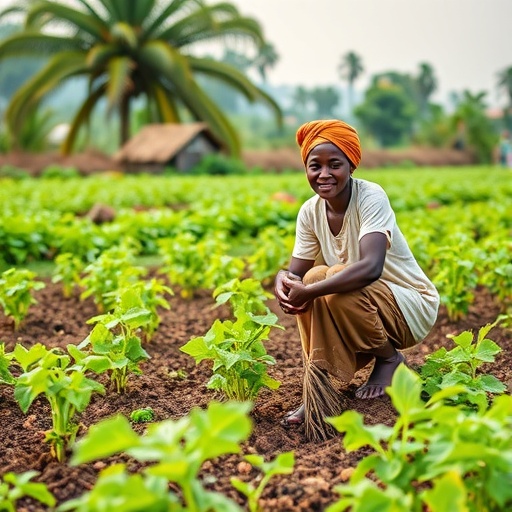Enset, often referred to as the “false banana,” emerges as a remarkable contributor to the agricultural landscape in central Ethiopia. This unique plant, cultivated predominantly in this region, offers a multifaceted role in promoting food security and enhancing livelihoods for countless communities. Umer, Regassa Tolossa, and Nigussie’s extensive research delve into the various dimensions of enset-based farming systems, revealing critical insights into its socio-economic significance and resilience.
The enset plant is not merely a staple food source; it embodies the rich cultural heritage and agricultural practices of the Ethiopian highlands. Thriving in an environment where many traditional crops struggle, enset serves as a vital resource that supports sustained agricultural productivity. This adaptability underscores the plant’s integral role in local food security and agricultural resilience, particularly amidst the challenges posed by climate change and variability.
The enset-based farming system is distinguished by its holistic approach, encompassing diverse agricultural practices and crop interdependencies. The cultivation of enset not only provides food but also offers an array of products, including fiber for weaving, bark for crafting, and leaves for animal feed. This multifunctionality enhances the overall resilience of farming systems and provides a safety net for households during challenging times, thus underscoring the importance of enset in rural livelihoods.
A critical aspect of enset farming is its contribution to nutritional security. The plant’s underground corms are rich in carbohydrates and can be stored for extended periods, serving as a reliable food source during lean months. This attribute becomes increasingly vital in a context where climate fluctuations threaten food availability. Through the integration of enset into their diet, communities benefit not only from a stable caloric intake but also from improved dietary diversity, which is essential for overall health and well-being.
Furthermore, the enset farming system fosters social cohesion and strengthens community ties. Traditional practices surrounding enset cultivation often involve collaborative efforts within families and among community members. Sharing knowledge about best practices, rituals associated with planting and harvesting, and collaborative labor arrangements create a sense of unity, enhancing the social fabric that underpins rural Ethiopian life.
In terms of its economic potential, enset represents a critical asset for rural households. Farmers engaged in enset cultivation have greater prospects for economic diversification, as the plant can be processed into various products, such as porridge and fermented beverages. These products not only meet local consumption needs but also offer avenues for market participation, enabling farmers to engage in trade and enhance their income-generating capacities.
Moreover, research indicates that the sustainability of enset-based farming systems hinges on several ecological and socio-economic factors. Sustainable agricultural practices, including agroforestry techniques and soil conservation measures, play a crucial role in maintaining the integrity of enset cultivation. These practices not only safeguard the natural resources upon which enset farming depends but also enhance biodiversity, promoting ecosystem services that benefit agriculture as a whole.
Climate resilience emerges as a cornerstone of the enset farming system. Enset’s hardiness in the face of adverse climatic conditions makes it a prime candidate for adaptation strategies. As unpredictable weather patterns increasingly threaten traditional agricultural crops, enset’s ability to endure drought and other stressors positions it as a potential resiliency anchor for farmers grappling with climate change.
However, while enset cultivation presents numerous advantages, it is not devoid of challenges. Land tenure issues, inadequate access to markets, and limited agricultural extension services hinder the full realization of enset’s potential. Addressing these challenges requires concerted efforts from policymakers, agricultural researchers, and local communities to build an enabling environment that fosters sustainable enset farming practices.
The intersection of enset farming with broader development goals highlights its relevance in achieving food security and bolstering livelihoods. Aligning enset cultivation with national agricultural policies can create pathways for enhanced support and investment in sustainable agricultural practices. By recognizing enset as a vital crop with substantial contributions to food systems, stakeholders can better target interventions that uplift rural communities.
Education and outreach play a pivotal role in advancing the understanding of enset’s benefits. Raising awareness about the significance of enset among farmers, agricultural professionals, and consumers can stimulate interest and investment in the crop. Community-driven training programs and knowledge exchanges can facilitate the dissemination of best practices, ensuring that the cultural knowledge of enset cultivation is preserved while adapting to contemporary agricultural innovations.
In conclusion, the research conducted by Umer, Regassa Tolossa, and Nigussie highlights the indispensable role that enset plays in supporting livelihoods and ensuring food security in central Ethiopia. Advocacy for enset as a central feature of sustainable agricultural development can pave the way for innovative strategies that address the challenges faced by rural communities. As attention to this remarkable plant grows, so too does the potential for enset to become a cornerstone of resilient, equitable food systems in Ethiopia and beyond.
Subject of Research: Enset based farming system in Ethiopia.
Article Title: Contribution of Enset based farming system in livelihoods and food security in central Ethiopia.
Article References:
Umer, S., Regassa Tolossa, A., Nigussie, A. et al. Contribution of Enset based farming system in livelihoods and food security in central Ethiopia.
Discov Sustain 6, 1169 (2025). https://doi.org/10.1007/s43621-025-02024-9
Image Credits: AI Generated
DOI: 10.1007/s43621-025-02024-9
Keywords: enset, food security, livelihoods, sustainable agriculture, climate resilience, Ethiopia.




